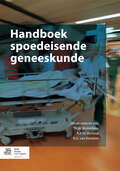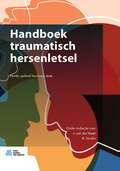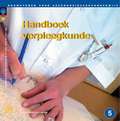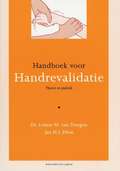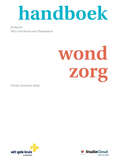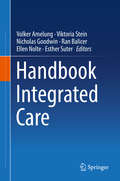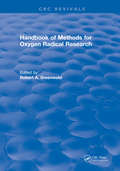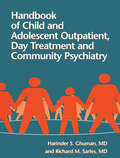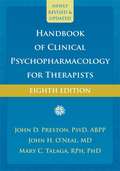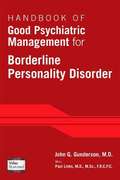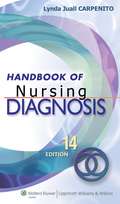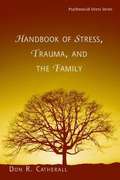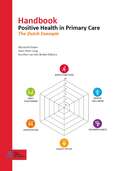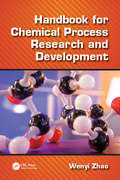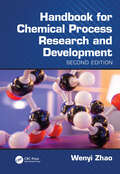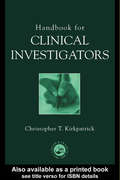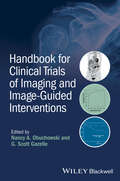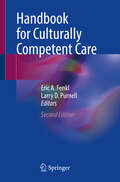- Table View
- List View
Handboek spoedeisende geneeskunde
by Th. W. Wulterkens R.A.M. Verbeek R.G. van KesterenIn Handboek spoedeisende geneeskunde wordt de ABCDE-systematiek van de spoedeisende geneeskunde nader uitgewerkt. Als enige in zijn soort biedt deze uitgave een uiteenzetting van alle aspecten per letter. Dat het boek niet alleen de ABCDE-systematiek bespreekt, maar ook in de volgorde ABCDE, is wat het boek zo uniek maakt.
Handboek traumatisch hersenletsel
by B. Jacobs J. van der NaaltDit boek geeft een overzicht van de diagnostiek, behandeling en gevolgen van traumatisch hersenletsel. De hoofdstukken zijn geschreven door landelijke experts, op basis van nationale en internationale literatuur en richtlijnen. Waar dat relevant is, is de inhoud toegespitst op de Nederlandse situatie, met als resultaat: een uniek Nederlandstalig naslagwerk. Dit handboek borduurt voort op Traumatische Hersenletsels van prof. dr. J.M. Minderhoud, maar is qua opzet geheel herzien. Het gaat in op de opvang van patiënten op de spoedeisende hulp, op de behandeling in het ziekenhuis (onder meer op de intensive care), op de restverschijnselen en op de mogelijkheden van revalidatiebehandeling. Ook de gevolgen voor werk en inkomen en juridische aspecten komen aan bod. De tekst is voorzien van talrijke verhelderende illustraties. Handboek traumatisch hersenletsel is bestemd voor alle zorgprofessionals die in hun praktijk te maken hebben traumatische hersenletsels, zoals medisch specialisten, huisartsen, verpleegkundigen, paramedici. Het boek is ook nuttig voor niet-medische professionals, zoals juristen. Joukje van der Naalt is neuroloog en hoogleraar Neurotraumatologie aan het Universitair Medisch Centrum Groningen. Bram Jacobs is neuroloog met als aandachtsgebied neurotraumatologie aan het Universitair Medisch Centrum Groningen.
Handboek verpleegkunde
by J.A.M. Kerstens E. M. Sesink J.H.J. Jong M. M. VermeulenBouwstenen voor gezondheidszorgonderwijs Handboek verpleegkunde.
Handboek voor de coassistent (Leidraadreeks Ser.)
by B. Schimmer W. J. Wiersinga M. Levi J. Savelkoel J.M.J. van der ZandeDe coschappen zijn het belangrijkste onderdeel van de masteropleiding geneeskunde. Tijdens de coschappen dient de theoretische kennis van de bachelor in de praktijk te worden gebracht. Deze overgang blijkt vele vragen en uitdagingen te geven. Hoe lees je een ECG in de praktijk? Hoe onderzoek je een pasgeboren baby? Waar let je op bij een thoraxfoto? Hoe test je de oogzenuwen? Hoe start je een antistollingsbeleid? Wat vertelt die labwaarde mij? Bij al dit soort dagelijkse vragen probeert dit boek de coassistent te helpen, om zo de overgang naar de praktijk te veraangenamen, maar deze bovenal efficiënter te laten verlopen. Het Handboek voor de coassistent geeft een goed beeld van de coschapperiode en wat de taken en verantwoordelijkheden van de coassistent zijn. De nadruk wordt gelegd op veelvoorkomende vragen en problemen die vrijwel zeker gedurende de coschappen zullen opduiken. Het handboek heeft een praktische insteek en bevat online aanvullend leesmateriaal. De hernieuwde editie is tot stand gekomen onder een nieuwgevormde redactie van specialisten en coassistenten. Centraal staat in deze druk het principe voor coassistenten door coassistenten.De thematisch geordende hoofdstukken zijn geschreven door coassistenten, samen met enthousiaste en vooraanstaande specialisten van perifere ziekenhuizen en alle faculteiten geneeskunde. Zij onderkennen de noodzaak om hun aanstaande collega’s de helpende hand te bieden en hen over de uiteenlopende aspecten van coschappen te informeren. Dit boek is in eerste instantie bedoeld voor coassistenten, maar wordt voorts aanbevolen aan studenten geneeskunde in de bachelorfase en beginnende assistenten.
Handboek voor handrevalidatie: Theorie en praktijk
by Louise M. Dongen Jan H. J. PilonDit boek geeft een volledig beeld van veel voorkomende aandoeningen van de hand. De benadering vanuit de klacht staat centraal in deze uitgave.Handboek voor handrevalidatie heeft een heldere indeling. Het boek begint met de functionele anatomie van hand en pols, waarna de congenitale afwijkingen worden behandeld. In hoofdstuk drie vindt u de behandeling van traumata, waarin de benadering vanuit de chirurg en de fysiotherapeut naar voren komt. Hoofdstuk vier en vijf gaan in op de benadering van degeneratieve aandoeningen en een aantal vaker voorkomende handaandoeningen, waaronder goedaardige en kwaadaardige tumoren. Verder geeft het boek u algemene adviezen voor het uitvoeren van fysiotherapie, informatie voor handtherapie bij een specifieke aandoening en het vervaardigen van diverse spalkjes. Het laatste hoofdstuk gaat in op leefregels en registratie.
Handboek wondzorg
by Wit-Gele Kruis Vlaanderen Sam Cordyn Kristel VliegherNog duidelijker, handiger en actueler. Drie in een! Het nieuwe 'Handboek wondzorg' is een nieuwe actualisering van de in 2004 verschenen bundeling van het 'Basisboek wondzorg' en 'Specifieke wondzorg deel 1 en 2', oorspronkelijk uitgebracht in 1997. Deze derde, herziene druk speelt in op de huidige trends en vernieuwingen in de dynamische wereld van de wondzorg. Kleurenillustraties ondersteunen de herziene teksten. De productbijlage is niet alleen samen met wondproductfabrikanten geactualiseerd, maar is nu ook net als het volledige handboek in een digitaal formaat beschikbaar. 'Handboek wondzorg' levert een bijdrage aan het comfort van de pati#65533;nt met een wond en aan de optimalisering van de wondzorg. Dit boek behandelt de theoretische achtergronden van de huid en gaat in op specifieke wondtypes zoals decubitus en brandwonden. Tevens beschrijft deze uitgave wondpijn en de relatie tussen wondzorg en voeding. Dit boek geniet de ondersteuning van de Belgische Woundcare Consultant Society (WCS). Deze volledig herziene uitgave is een praktisch handboek voor zorgverleners. Het is bijzonder geschikt voor gebruik in de extra- en intramurale zorg. Daarnaast kan het boek uitstekend dienstdoen als studieboek in het reguliere verpleegkundeonderwijs en bij wondzorggerelateerde nascholingscursussen. div>
Handbook For Public Health Social Work (Springer Ser.)
by Robert Keefe Elaine T. JurkowskiPublic health social work is an interdisciplinary, epidemiologically oriented approach to improving human health and well-being. About one quarter of all social workers in the United States currently work in medical or public health settings, a number that is expected to increase significantly in coming years. This handbook, written and edited by respected leaders of the Social Work Section of the American Public Health Association (APHA), describes the rapidly expanding roles of public health social workers as these two disciplines continue to join forces. The handbook describes how the alliance of social work and public health has already made significant progress and ways in which it will further improve health care in the United States. It addresses job opportunities for public health social workers in such fields as disease prevention, health promotion, child welfare, gerontology, disaster response, trauma intervention, substance abuse, outreach services, and advocacy. It also covers public health social work with special populations and in neighborhood, rural, and global settings.
Handbook Integrated Care
by Volker Amelung Viktoria Stein Nicholas Goodwin Ran Balicer Ellen Nolte Esther SuterThis handbook shares profound insights into the main principles and concepts of integrated care. It offers a multi-disciplinary perspective with a focus on patient orientation, efficiency, and quality by applying widely recognized management approaches to the field of healthcare. The handbook also highlights international best practices and shows how integrated care can work in various health systems. In the majority of health systems around the world, the delivery of healthcare and social care is characterised by fragmentation and complexity. Consequently, much of the recent international discussion in the fields of health policy and health management has focused on the topic of integrated care. “Integrated” acknowledges the complexity of patients’ needs and aims to meet them by taking into account both health and social care aspects. Changing and improving processes in a coordinated way is at the heart of this approach. The second edition offers new chapters on people-centredness, complexity theories and evaluation methods, additional management tools and a wealth of experiences from different countries and localities. It is essential reading both for health policymakers seeking inspiration for legislation and for practitioners involved in the management of public health services who want to learn from good practice.
Handbook Integrated Care
by Volker Amelung, Viktoria Stein, Nicholas Goodwin, Ran Balicer, Ellen Nolte and Esther SuterThis handbook gives profound insight into the main ideas and concepts of integrated care. It offers a managed care perspective with a focus on patient orientation, efficiency, and quality by applying widely recognized management approaches to the field of health care. The handbook also provides international best practices and shows how integrated care does work throughout various health systems. The delivery of health and social care is characterised by fragmentation and complexity in most health systems throughout the world. Therefore, much of the recent international discussion in the field of health policy and health management has focused on the topic of integrated care. “Integrated” acknowledges the complexity of patients´ needs and aims to meet it by taking into account both health and social care aspects. Changing and improving processes in a coordinated way is at the heart of this approach.
Handbook Methods For Oxygen Radical Research
by Robert A. GreenwaldThis volume is divided into five sections. Section I deals with preparative methodology for isolation and purification of the components of the oxy radical experimental systems use most frequently, including all three forms of SOD and several other important scavengers. Section II provides the experimenter with a choice of a dozen oxy radical generating systems which can be used for testing of scavengers or for evaluation of the effects of oxy radicals on target tissues. The reader will note that in this section, as well as in most of the rest of the volume, the orientation is primarily biochemical, biologic, and medical, rather than pure chemistry or pure physics. Nevertheless, the techniques are widely applicable to a variety of disciplines.
Handbook Of Adolescent Inpatient Psychiatric Treatment
by Harinder S. Ghuman Richard M. SarlesFirst published in 1994. Routledge is an imprint of Taylor & Francis, an informa company.
Handbook Of Child And Adolescent Outpatient, Day Treatment A
by Harinder S. Ghuman Richard M. SarlesIn the past few years, there has been a major shift in the mental health care of child and adolescents from inpatient care to non-hospital community ambulatory settings. Economic pressures have primarily driven this change in service delivery. Insurance companies and managed care organizations have not only restricted access to hospitalization and limited length of stays but additionally have sharply reduced reimbursements for treatments. State and federal policies for inpatient treatment and reimbursement have followed similar trends. As a result, mental health planners have attempted to develop programs to deal with this trend of restricted inpatient care shifting treatment of children and adolescents to home and community settings. Some of these new programs are well planned and others are hastily planned and implemented. The pitfall to this community approach is that there is a population of chronically disturbed children and adolescents, and highly stressed parents often lacking adequate personal and family resource who may not respond to these new less restrictive, less costly community approaches which potentially may lead to an unsafe and dangerous situation for the child, adolescent, family and the community.With this in mind, the purpose of this book is to provide comprehensive and up-to-date information regarding child and adolescent outpatient, day treatment and community psychiatry. The emphasis of this book is to provide practical knowledge through clinical case illustrations and to explain various strategies in a detailed fashion.
Handbook Of Clinical Psychopharmacology For Therapists
by John D. Preston John H. O'Neal Mary C. TalagaThis book is intended primarily for mental health professionals and those in graduate training in psychology, social work, psychiatric nursing, and counseling. The professional goal of most readers will be to provide services that aim to reduce emotional pain, to promote psychological growth and healing
Handbook Of Clinical Psychopharmacology For Therapists
by John D. Preston John H. O'Neal Mary C. TalagaA comprehensive professional resource for mental health treatment―now in a fully revised and updated ninth editionThe Handbook of Clinical Psychopharmacology for Therapists is the gold standard for mental health clinicians looking for clear, reliable information about the pharmacological treatment of mental health issues. Organized by disorder and, within each disorder, by medication, this book is designed to familiarize clinicians and students with the basic terminology and models of psychopharmacology. This fully revised and updated ninth edition provides essential information on new medications and treatment options and includes the latest research on side effects, contraindications, and efficacy of all major medications prescribed for mental health disorders. You’ll also find new chapters on sleep disorders and experimental treatments, updated information on child and adolescent psychopharmacology and the latest best practices for treating pregnant and breastfeeding patients and patients with substance use disorders.This handbook makes it simple to: get the facts about drug interactions and side effects; find out how medications affect adults, children, and adolescents differently; learn how different cultures view medical treatment, vital information for anyone who treats clients from a variety of backgrounds; and discontinue medication safely when needed.This essential guide to psychopharmacology has been adopted as a textbook at universities nationwide and is an important resource for every therapist’s library.
Handbook Of Good Psychiatric Management For Borderline Personality Disorder
by John G. Gunderson Paul S. LinksThe Handbook of Good Psychiatric Management for Borderline Personality Disorder teaches clinicians what to do and how to do it, as well as what not to do and how to avoid it. The author, a renowned researcher and clinician, has developed a new evidence-based treatment, Good Psychiatric Management (GPM) that comfortably utilizes cognitive, behavioral, and psychodynamic interventions that are practical and simple to implement. Because psychoeducation is an important component of GPM, the book teaches clinicians how to educate their patients about BPD, including the role of genetics and the expected course of the disease. This approach offers advantages both to practitioners, who become more adept at honest communication, and to patients, who are encouraged to have realistic hopes and to focus on strategies for coping with BPD in daily life.
Handbook Of Nursing Diagnosis 14th Edition
by Lynda Juall CarpenitoThe ideal quick reference, this handbook offers practical guidance on nursing diagnoses and associated care. Sections cover Nursing Diagnoses, Health Promotion/Wellness Nursing Diagnoses, and Diagnostic Clusters--medical conditions with relevant collaborative problems and nursing diagnoses. NEW! The newest nursing diagnoses approved by NANDA International for 2012-2014 are included in this edition.
Handbook Of Stress, Trauma, And The Family (Routledge Psychosocial Stress)
by Don R. CatherallThe Handbook of Stress, Trauma, and the Family is broken down into three sections, compiling research, theory and practice. The first section focuses on how traumatic stress affects intimate others, what familial characteristics affect individual susceptibility to trauma, as well as evaluation of the effectiveness of various interventions. The section on theory explores concepts of stress and intrapsychic processes underlying the intergenerational transmission of trauma, addressesing how families can buffer or enhance anxiety. The final section, entitled practice, covers assessment (presenting both the Circumplex Model and Bowenian family theory models), treatment models and treatment formats for specific populations. The major family treatment models applicable to stress and trauma are discussed, including contextual, object relations, emotionally focused and critical interaction therapy.
Handbook Positive Health in Primary Care: The Dutch Example
by Machteld Huber Hans Peter Jung Karolien van den Brekel-DijkstraIncreasing numbers of general practitioners are discovering the benefits of working with Positive Health. It helps to talk with patients in a different way, with a focus on possibilities rather than on the impossibilities related to a particular health problem. This is good for the patient. And for the general practitioner. But how do we apply Positive Health? This handbook provides useful tools!The book is full of tips, tells the story of how the concept was first developed and gives practical examples. It explains the underlying scientific basis of Positive Health — with a clear emphasis on what is meaningful to patients. And, above all, this book invites you to start working with Positive Health on various levels — in your consulting room, your practice and in the local community. Because cooperation and combined effort are key. You will experience how Positive Health seamlessly fits the core values and challenges of all aspects of primary care. The handbook is intended for all primary care professionals as well as those who are still in training. It describes the Dutch health care system and the experiences related to inspiration, implementation and the anchoring of the Positive Health concept into this system. The publication is indispensable for anyone who wants to provide meaningful primary care using the Positive Health concept. ‘When I heard about Positive Health and the spider web, I felt that it gave us a much wanted tool to empower our patients and the community.’ Elínborg Bárðardóttir, general practitioner & programme director primary care training, Primary Healthcare in Iceland
Handbook for Chemical Process Industries
by Himanshu J PatelChemical processing industry plays a pivotal role in the economy of a country, as chemicals are required in every sphere of our lives. This book covers chemical processing of dyes, pigments, drugs and pharmaceutical products, fermented products, agrochemicals, explosives, polymers, Period II and III chemicals, chemicals, sugar, coatings, starches, soaps and detergents, paper, pulp, glass, and cement. It includes sources of natural materials, collection process, purification, and extraction of different chemicals from natural materials like petroleum, coal and ores from the Earth. It includes manufacturing details of C1 to C4 and aromatic compounds obtained from natural materials. The book covers both traditional and modern sectors of the chemical processing industry. It provides knowledge on the properties of the chemical and manufacturing process (such as raw materials, chemical reactions, quantitative requirement, flow sheet diagram, procedure) and its uses. The book is based on the author's expertise and has been developed with an awareness of the quantitative requirement for manufacturing chemicals. Data has been collected from industry, thus it will be useful to industry personnel, research groups, academicians and institutional organizations.
Handbook for Chemical Process Research and Development
by Wenyi ZhaoThe Handbook for Chemical Process Research and Development focuses on developing processes for chemical and pharmaceutical industries. Forty years ago there were few process research and development activities in the pharmaceutical industry, partially due to the simplicity of the drug molecules. However, with the increasing structural complexity, especially the introduction of chiral centers into the drug molecules and strict regulations set by the EMA and FDA, process R&D has become one of the critical departments for pharmaceutical companies. This book assists with the key responsibility of process chemists to develop chemical processes for manufacturing pharmaceutical intermediates and final drug substances for clinical studies and commercial production.
Handbook for Chemical Process Research and Development, Second Edition
by Wenyi ZhaoThis fully updated second edition reflects the significant changes in process chemistry since the first edition and includes more common process issues such as safety, cost, robustness, and environmental impact. Some areas have made notable progress such as process safety, stereochemistry, new reagents and reagent surrogates. Forty years ago there were few process research and development activities in the pharmaceutical industry, partly due to the simplicity of drug molecules. With increasing structural complexity especially the introduction of chiral centers into drug molecules and stricter regulations, process R&D has become one of the critical departments for pharmaceutical companies. Features: This unique volume now in its second edition is designed to provide readers with an unprecedented strategy and approach which will help chemists and graduate students develop chemical processes in an efficient manner. Promotes an industrial mindset concerning safety and commercial viability when developing methods. The author discusses development strategies with case studies and experimental procedures. Focuses on mechanism-guided process development which provides readers with practical strategies and approaches. Addresses more common process issues such as safety, cost, robustness, and environmental impact. This book provides a new direction for scientists, researchers, and students in materials science and polymer chemistry who seek to better understand the chemistry behind conducting polymers and improve their performance for use in advanced energy applications.
Handbook for Clinical Investigators
by Christopher KirkpatrickThis text is aimed at potential clinical investigators usually physicians, especialy those thinking about doing clinical trials to evaluate new drugs - mostly sponsored by pharmaceutical companies.
Handbook for Clinical Trials of Imaging and Image-Guided Interventions
by Nancy A. Obuchowski G. Scott GazelleHandbook for Clinical Trials of Imaging and Image-Guided Interventions is the first single-source, multi-disciplinary reference, based on the didactic sessions presented at the annual 'Clinical Trials Methodology Workshop' for radiologists, radiation oncologists and imaging scientists (sponsored by the Radiological Society of North America (RSNA)). It focuses on educating radiologists, radiation oncologists and those involved in imaging research with how to design and conduct clinical trials to evaluate imaging technology and imaging biomarkers. The internationally renowned contributors take a broad approach, starting with principles of technology assessment, and then move into specific topics covering the clinical trials of therapy and clinical research in imaging guided interventions including radiotherapy. They discuss the use of imaging as a predictor of therapeutic response, screening trial design, and the practicalities of how to run an efficient clinical trial and good working practices. Later chapters provide a comprehensive array of quantitative methods including: an introduction to statistical considerations in study design, biostatistical analysis methods and their role in clinical imaging research, methods for quantitative imaging biomarker studies, and an introduction to cost effectiveness analysis. Handbook for Clinical Trials of Imaging and Image-Guided Interventions will educate and prepare radiologists at all levels and in all capacities in planning and conducting clinical imaging trials.
Handbook for Culturally Competent Care
by Larry D. Purnell Eric A. FenklThis concise, easy-to-read book tackles the potentially awkward subject of culture in a direct, non-intimidating style. It prepares all health professionals in any clinical setting to conduct thorough assessments of individual from culturally specific population groups, making it especially valuable in today's team-oriented healthcare environment. The book is suitable for healthcare workers in all fields, particularly nurses who interact with the patients 24 hours a day, every day of the week. Based on the Purnell Model for Cultural Competence, it explores 26 different cultures and the issues that healthcare professionals need to be sensitive to. For each group, the book includes an overview of heritage, communication styles, family roles and organization, workforce issues, biocultural ecology, high-risk health behaviors, nutrition, pregnancy and child bearing, death rituals, spirituality, healthcare practices, and the views of healthcare providers. It also discusses the variant characteristics of culture that determine the diversity of values, beliefs, and practices in an individual's cultural heritage in order to help prevent stereotyping. These characteristics include age, generation, nationality, race, color, gender, religion, educational status, socioeconomic status, occupation, military status, political beliefs, urban versus rural residence, enclave identity, marital status, parental status, physical characteristics, sexual orientation, gender issues, health literacy, and reasons for migration. Each chapter offers specific instructions, guidelines, tips, intervention strategies, and approaches specific to a particular cultural population.
Handbook for Culturally Competent Care
by Larry D. Purnell Eric A. FenklThe second edition of this incisive book, based on the Purnell Model for Cultural Competence, addresses the potentially challenging topic of culture in a forthright style. It is a valuable resource in today's team-based healthcare environment, preparing health professionals, regardless of setting, to conduct in-depth assessments of individuals and families from culturally specific population groups. This book will appeal to all healthcare workers in all fields, and it is particularly suitable for nurses interacting with patients in very diverse settings. This book delves into 32 different cultures and areas of support common to all individuals and families that health professionals must recognize and consider. African American, American Indian, Brazilian, Cuban, Chinese, Korean and Filipino, but also Arab, Hindu or Haitian, as well as many European heritages are examined among others. Brand new chapters explore Greek, Italian, Jamaican, Thai, and Ukrainian heritages. For each culture, chapters detail communication styles, family roles, workforce issues, biocultural ecology and high-risk health behaviours. Also discussed are nutrition, pregnancy and child bearing, death rituals, spirituality, healthcare practices, and the perceptions of traditional, magico-religious, and bio-medical healthcare providers. Culture’s characteristics - such as age, generation, gender, religion, educational/marital/parental/socioeconomic or even military status, but also political beliefs, physical characteristics, sexual orientation or gender issues - determining the diversity of values, beliefs, and practices in an individual's cultural heritage in order to help prevent stereotyping are discussed. At the end of each chapter, readers are provided with specific instructions, guidelines, tips, intervention strategies, and approaches specific to a particular cultural population. Additionally, reflective exercises help the reader reinforce the concepts presented in each chapter. For this second edition, most of the chapters are authored by individuals who either identify with the culture being addressed in the chapter or have personal knowledge of the culture via life experiences.
